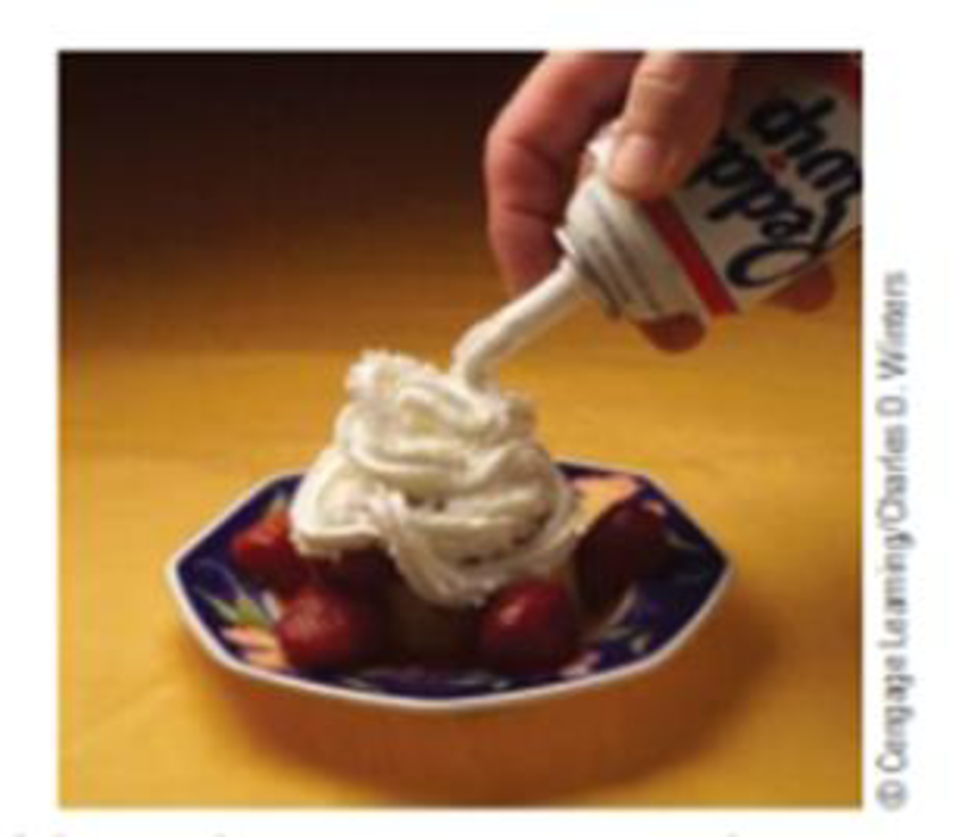
Concept explainers
Dinitrogen monoxide, N2O (commonly called nitrous oxide), is prepared by the careful decomposition of ammonium nitrate and is used as an oxidizing agent in rocket engines as well as a weak general anesthetic (where you may know it as “laughing gas”). However, it is also known to be a powerful greenhouse gas. In a Science magazine article, it was stated that “Human activities may be causing an unprecedented rise in the terrestrial N2O source. Marine N2O production may also rise substantially as result of eutrophication, warming and ocean acidification.” [L. A. Codispoti, Science, Vol. 327, pp. 1339-1340, 2010.]

The powerful greenhouse gas N2O is used as a propellant in cans of instant whipped cream.
- (a) Draw a Lewis electron dot structure for N2O, and specify the formal charge on each atom and the molecular geometry.
- (b) The atom connections are N—N—O. Why is the connection N—O—N not likely?
The highest N2O concentration observed in the ocean is about 800 nM (nanomolar). At this concentration, what is the mass of N2O per liter?
Trending nowThis is a popular solution!

Chapter 20 Solutions
Chemistry & Chemical Reactivity
- Explain the difference between the effects of ground- level ozone and stratospheric ozone. Why is one beneficial to human life, whereas the other is not?arrow_forwardFor the reaction C614N714+?, if 100.0 g of carbon reacts, what volume of nitrogen gas (N2) is produced at 273K and 1 atm?arrow_forwardChlorine atoms contribute to the destruction of the Earths ozone layer by the following sequence of reactions: Cl + O3 ClO + O2 ClO + O Cl + O2 where the O atoms in the second step come from the decomposition of ozone by sunlight: O3(g) O(g) + O2(g) What is the net equation on summing these three equations? Why does this lead to ozone loss in the stratosphere? What is the role played by Cl in this sequence of reactions? What name is given to species such as ClO?arrow_forward
- As weather balloons rise from the earths surface, the pressure of the atmosphere becomes less, tending to cause the volume of the balloons to expand. However, the temperatura is much lower in the upper atmosphere than at sea level. Would this temperatura effect tend to make such a balloon expand or contract? Weather balloons do, in fact, expand as they rise. What does this tell you?arrow_forward62 Ammonium dinitramide (ADN), NH4N(NO2)2, was considered as a possible replacement for aluminium chloride as the oxidizer in the solid fuel booster rockets used to launch the space shuttle. When detonated by a spark, AND rapidly decomposes to produce a gaseous mixture of N2,O2, and H2O. (This is not a combustion reaction. The ADN is the only reactant.) The reaction releases a lot of heat, so the gases are initially formed at high temperature and pressure. The thrust of the rocket results mainly from the expansion of this gas mixture. Suppose a 2.3-kg sample of ADN is denoted and decomposes completely to give N2,O2, and H2O. If the resulting gas mixture expands until it reaches a temperature of 100°C and a pressure of 1.00 atm, what volume will it occupy? Is your answer consistent with the proposed use of ADN as a rocket fuel?arrow_forwardHow does hydraulic fracturing differ from previously used techniques for the recovery of natural gas from the earth?arrow_forward
- The toy rockets were engineered so well that now you have dreams of creating a real life replica that can carry people to the space station. Aspirations of becoming rich and famous overcome your thoughts. You know that when this compound (Ammonium perchlorate) is heated at 200 C, it breaks down to a variety of gasses, including N2(g), Cl2(g), O2(g), and H2O(g). You know that the rocket will fly due to the sudden appearance of hot gaseous products in a small initial volume that will result from the rapid increase in the pressure and temperature. What total pressure of gas would be able to be produced at 800 C by igniting 7.0X10^5 kg of NH4ClO4 and allowing it to expand to a volume of 6.4X10^6 L? (ideal gas behavior) Full solution pleasearrow_forwardIn February I travel 100 miles everyday In June I travel 5 miles a week. My car gets 28 miles per gallon. Please show steps Using your cars miles per gallon and the miles you drive in 1 week calculate the liters of carbon dioxide you produce when using your car. Compare your miles in February (pre-covid) versus June (post-covid). Assume that your engine combusts at 1.00 atm and 25.0 celsius. Assume that your gasoline is 100% octane (C8H18). You will also need to balance the combustion reaction that occurs in your car engine. You will need to use PV=nRTarrow_forward
 Chemistry & Chemical ReactivityChemistryISBN:9781337399074Author:John C. Kotz, Paul M. Treichel, John Townsend, David TreichelPublisher:Cengage Learning
Chemistry & Chemical ReactivityChemistryISBN:9781337399074Author:John C. Kotz, Paul M. Treichel, John Townsend, David TreichelPublisher:Cengage Learning Chemistry & Chemical ReactivityChemistryISBN:9781133949640Author:John C. Kotz, Paul M. Treichel, John Townsend, David TreichelPublisher:Cengage Learning
Chemistry & Chemical ReactivityChemistryISBN:9781133949640Author:John C. Kotz, Paul M. Treichel, John Townsend, David TreichelPublisher:Cengage Learning Chemistry for Engineering StudentsChemistryISBN:9781337398909Author:Lawrence S. Brown, Tom HolmePublisher:Cengage Learning
Chemistry for Engineering StudentsChemistryISBN:9781337398909Author:Lawrence S. Brown, Tom HolmePublisher:Cengage Learning Chemistry for Engineering StudentsChemistryISBN:9781285199023Author:Lawrence S. Brown, Tom HolmePublisher:Cengage Learning
Chemistry for Engineering StudentsChemistryISBN:9781285199023Author:Lawrence S. Brown, Tom HolmePublisher:Cengage Learning ChemistryChemistryISBN:9781305957404Author:Steven S. Zumdahl, Susan A. Zumdahl, Donald J. DeCostePublisher:Cengage Learning
ChemistryChemistryISBN:9781305957404Author:Steven S. Zumdahl, Susan A. Zumdahl, Donald J. DeCostePublisher:Cengage Learning Chemistry: An Atoms First ApproachChemistryISBN:9781305079243Author:Steven S. Zumdahl, Susan A. ZumdahlPublisher:Cengage Learning
Chemistry: An Atoms First ApproachChemistryISBN:9781305079243Author:Steven S. Zumdahl, Susan A. ZumdahlPublisher:Cengage Learning





